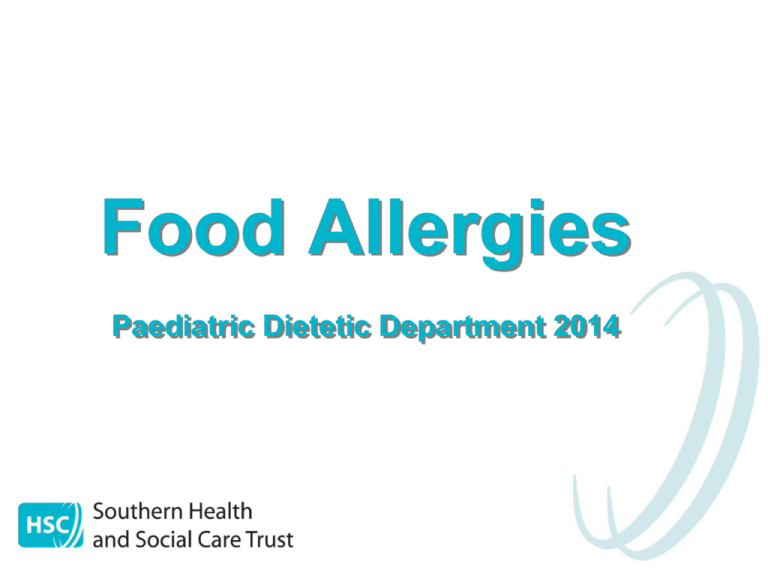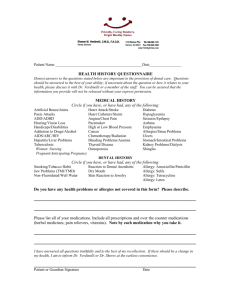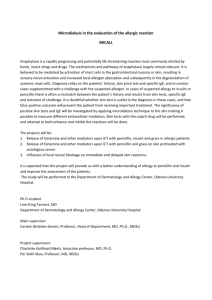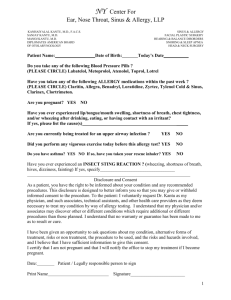Food Allergy Awareness pptx 1.41MB
advertisement

Food Allergies Paediatric Dietetic Department 2014 Aims Of The Session Increase awareness of Common types of food allergy Symptoms of food allergy Practical considerations for management of food allergy in schools Food Allergy 6-8% of children have a proven food allergy Food allergies occur when the body’s immune system perceives a food protein to be harmful & acts against it As a result of this action, chemicals are released (e.g. histamine) and it is these chemicals which cause symptoms There is no cure for food allergy, complete and strict avoidance of the food is the only way to prevent a reaction NICE guidelines, 2011 www.bda.uk.com/foodfacts/allergy Types of Reaction IgE Non-IgE Quick ‘Acute’ onset Anaphylaxis Well-defined mechanism Fairly easy to diagnose Validated tests -Specific serum IgE assays -Skin Prick Tests -+/- supervised Challenges Mild to moderate ‘Delayed’ onset Mechanisms unclear Harder to diagnose No validated tests - Elimination diet with planned challenge NICE Guidelines 2011 Possible Food Allergy Symptoms IgE mediated Symptoms Non IgE mediated symptoms The skin Acute Pruritus Pruritis Erythema Erythema Acute angioedema (most commonly in the lips and face, and around the eyes) Significant atopic eczema Urticaria Possible Food Allergy Symptoms IgE mediated symptoms Non-IgE mediated symptoms Gastrointestinal system Colicky abdominal pain Abdominal discomfort Vomiting Gastro-oesophageal reflux disease Diarrhoea Loose or frequent stools, constipation, blood or mucus in stools Food refusal or aversion Perianal redness Faltering growth Possible Food Allergy Symptoms IgE mediated Symptoms Respiratory System (usually in combination with one or more of the previous symptoms and signs) Upper respiratory tract symptoms (nasal itching, sneezing, rhinorrhoea or congestion [with or without conjunctivitis]) Lower respiratory tract symptoms (cough, chest tightness, wheezing or shortness of breath) Life Threatening Anaphylaxis Symptoms All of the symptoms of IgE mediated reaction Difficulty breathing Swelling around tongue / throat Redness of skin Collapse →Adrenaline auto injector Note, not all children with a food allergy will experience anaphylactic symptoms Which foods are involved? For children the most common food allergies are: Cows milk Protein Eggs Peanuts Tree nuts Fish Shellfish Cow’s Milk Allergy (CMA) Occurs when the body’s immune system reacts to proteins found in milk Up to 7% of children have a CMA and usually presents in infancy Most children will outgrow it (average age 5 years for IgE mediated and majority by age 3 years for uncomplicated non-IgE mediated allergy) BMJ 2013;347:f5424 Cows Milk Containing Foods: Cows milk Butter Yoghurt Cheese Margarine Ice cream Cream Milk powder Breads containing milk such as pancake, wheaten, soda Cakes, buns, biscuits, chocolate Processed foods Egg Allergy Egg allergy can be: – - mild i.e. can tolerate well cooked egg - severe i.e. can’t tolerate any form of egg ~50% of children with egg allergy can eat well cooked egg e.g. cakes and biscuits Children who are allergic to loosely cooked or raw egg, the reactions are often severe ~50% of children grow out of an egg allergy in about the first 5-7 years of life, but in the rest it is likely to persist www.anaphylaxis.org.uk WELL COOKED EGG LOOSELY COOKED EGG RAW EGG Cakes, biscuits Meringues Fresh mousse Dried egg pasta Lemon curd Fresh Mayonnaise Prepared meat dishes and sausages containing egg Scrambled, boiled, poached or fried egg Some ice-creams, (especially fresh and deluxe types) and sorbets Egg glaze on pastry Quiche Royal Icing Gravy granules (if they contain egg) Omelette Horseradish, tartar sauce Pancakes and scotch pancakes (shop bought) Egg custard Some cheeses Egg in batter Raw egg in cake mix Breadcrumbs Inside a Cadbury's cream egg Homemade pancakes Nut Allergy Unlike milk or egg allergies, children are unlikely to grow out of a nut allergy (about 1 in 5 will grow out of it) Most first allergic reactions take place when child is between 14 months and 2 years old The nut allergy may become less severe with age, but in 20%, it can become worse with time www.allergyuk.org/peanut-and-tree-nutallergy Peanuts PEANUTS Arachis hypogaea Groundnuts Beer nuts Goober nut/pea Cacahuete Mandelonas Chinese nuts Monkey nuts Earthnuts Tree Nuts TREE NUTS Almond Macadamia Brazil Pecan Cashew Pistachio Hazelnut Walnut Food Labelling Children with a nut allergy are advised to avoid all nuts including foods which: – -‘may contain traces of nuts’ or – -‘made in a factory which handles nuts’ – unless individual medical/dietetic advice has been given to family Food Labelling Current allergen labelling rules will be changing on 13 December 2014. Many businesses are already starting to make changes to how they label allergens on their products. Under the new rules, allergens will be emphasised on the label. Other Considerations Trips - careful forward planning Cookery - check ingredients and provide alternatives if necessary Treat days - supply any special snacks or "birthday treats" in a labelled tin No sharing snacks – remind children each to eat their own snack Other Considerations School meals & Packed lunch – ‘free-from’ status (e.g. milk, eggs and nuts) Activities e.g. arts and crafts - glues, paints, and old food cartons that may include food allergens Cross contamination – take extra care with hand washing especially after lunch/snacks Pets – bird seed, other pet foods Food Allergy Resources www.food.gov.uk/allergy Allergy UK www.foodallergyuk.org The Anaphylaxis Campaign www.anaphylaxis.org.uk The British Dietetic Association www.bda.uk.com National Institute of Clinical Excellence, 2011 Thank you for listening! Any questions?





